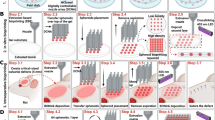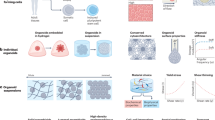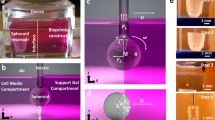Abstract
Aspiration-assisted bioprinting (AAB) is a versatile biofabrication technique that enables the precise and selective patterning of biologics, such as tissue spheroids and organoids, addressing limitations of conventional bioprinting techniques. AAB facilitates the fabrication of (1) tissues with physiologically relevant cell densities using spheroids and (2) advanced tissue models that replicate three-dimensional microenvironments essential for studying cellular responses, disease development and drug testing. Here we provide reliable and reproducible guidelines for the precise positioning of abovementioned biologics, incorporating two operational modes: (1) a single-nozzle mode for precise, one-by-one bioprinting and (2) a high-throughput mode using a digitally controllable nozzle array, enabling the rapid and simultaneous placement of multiple spheroids for scalable tissue fabrication. Comprehensive instructions are included for setting up the AAB platform, operating software and key operational procedures, including optimization of bioprinting conditions. This Protocol enables users to build and operate their own AAB platform depending on target applications, achieving fine control over spheroid positioning through successful aspiration and their precise placement under optimized conditions. This Protocol enables the setup of the AAB platform within 1–2 d. Bioprinting time varies depending on the number of spheroids to bioprint: the single-nozzle mode requires ~30 s per spheroid, while the high-throughput mode can print 64 spheroids in 3–4 min. Designed for accessibility and adaptability, this Protocol is suitable for users from a variety of backgrounds, including engineering, biology, pharmacy and medical sciences, who require bioprinting of spheroids for creating microphysiological systems for drug testing and disease modeling and implantable grafts for regenerative medicine.
Key points
-
Aspiration-assisted bioprinting (AAB) is a versatile biofabrication technique that enables the precise and selective patterning of biologics, such as tissue spheroids and organoids. This Protocol provides comprehensive instructions for setting up the AAB platform, operating software and key operational procedures, including the optimization of bioprinting conditions.
-
AAB overcomes the limitations of conventional bioprinting techniques, enabling flexible, precise, heterogeneous and scalable spheroid bioprinting across both two-dimensional and three-dimensional configurations.
This is a preview of subscription content, access via your institution
Access options
Access Nature and 54 other Nature Portfolio journals
Get Nature+, our best-value online-access subscription
$32.99 / 30 days
cancel any time
Subscribe to this journal
Receive 12 print issues and online access
$259.00 per year
only $21.58 per issue
Buy this article
- Purchase on SpringerLink
- Instant access to full article PDF
Prices may be subject to local taxes which are calculated during checkout









Similar content being viewed by others
Data availability
The main data discussed in this Protocol are available in supporting primary research publications. STL files used in this Protocol are accessible via figureshare.com at https://doi.org/10.6084/m9.figshare.28405133.v1 (ref. 35). Example datasets to demonstrate the software for prepositioning (Steps 145–151) and automated motion movement (Steps 117–118) are provided in the Supplementary data.
Code availability
The AAB software can be accessed in the Supplementary software. Details of the software interface and instructions were included in the manuscript. We will post updated versions of the software via our GitHub repository at https://github.com/MHKim-software/HITS-Bio.git, if necessary.
References
Fennema, E., Rivron, N., Rouwkema, J., van Blitterswijk, C. & De Boer, J. Spheroid culture as a tool for creating 3D complex tissues. Trends Biotechnol. 31, 108–115 (2013).
Dababneh, A. B. & Ozbolat, I. T. Bioprinting technology: a current state-of-the-art review. J. Manuf. Sci. Eng. 136, 061016 (2014).
Dey, M. et al. Chemotherapeutics and CAR‐T cell‐based immunotherapeutics screening on a 3D bioprinted vascularized breast tumor model. Adv. Funct. Mater. 32, 2203966 (2022).
Ayan, B. et al. Aspiration-assisted freeform bioprinting of pre-fabricated tissue spheroids in a yield-stress gel. Commun. Phys. 3, 183 (2020).
Kim, M. H., Banerjee, D., Celik, N. & Ozbolat, I. T. Aspiration-assisted freeform bioprinting of mesenchymal stem cell spheroids within alginate microgels. Biofabrication 14, 024103 (2022).
Wu, Y. et al. Hybrid bioprinting of zonally stratified human articular cartilage using scaffold‐free tissue strands as building blocks. Adv. Healthc. Mater. 9, 2001657 (2020).
Ayan, B. et al. Aspiration-assisted bioprinting for precise positioning of biologics. Sci. Adv. 6, eaaw5111 (2020).
Kim, M. H. et al. High-throughput bioprinting of spheroids for scalable tissue fabrication. Nat. Commun. 15, 10083 (2024).
Heo, D. N. et al. Aspiration-assisted bioprinting of co-cultured osteogenic spheroids for bone tissue engineering. Biofabrication 13, 015013 (2020).
Dey, M. et al. Biofabrication of 3D breast cancer models for dissecting the cytotoxic response of human T cells expressing engineered MAIT cell receptors. Biofabrication 14, 044105 (2022).
Celik, N. et al. miRNA induced 3D bioprinted-heterotypic osteochondral interface. Biofabrication 14, 044104 (2022).
Celik, N., Kim, M. H., Hayes, D. J. & Ozbolat, I. T. miRNA induced co-differentiation and cross-talk of adipose tissue-derived progenitor cells for 3D heterotypic pre-vascularized bone formation. Biofabrication 13, 044107 (2021).
Banerjee, D. et al. Biofabrication of an in-vitro bone model for Gaucher disease. Biofabrication 15, 045023 (2023).
Ayan, B., Wu, Y., Karuppagounder, V., Kamal, F. & Ozbolat, I. T. Aspiration-assisted bioprinting of the osteochondral interface. Sci. Rep. 10, 13148 (2020).
Alioglu, M. A. et al. Nested biofabrication: matryoshka‐inspired intra‐embedded bioprinting. Small Methods 8, 2301325 (2024).
Dey, M., Ayan, B., Yurieva, M., Unutmaz, D. & Ozbolat, I. T. Studying tumor angiogenesis and cancer invasion in a three‐dimensional vascularized breast cancer micro‐environment. Adv. Biol. 5, 2100090 (2021).
Daly, A. C., Davidson, M. D. & Burdick, J. A. 3D bioprinting of high cell-density heterogeneous tissue models through spheroid fusion within self-healing hydrogels. Nat. Commun. 12, 753 (2021).
Han, G. et al. 3D printed organisms enabled by aspiration‐assisted adaptive strategies. Adv. Sci. 11, 2404617 (2024).
Roth, J. G. et al. Spatially controlled construction of assembloids using bioprinting. Nat. Commun. 14, 4346 (2023).
Ellison, S. T. et al. Cellular micromasonry: biofabrication with single cell precision. Soft Matter 18, 8554–8560 (2022).
Liu, Y. et al. hESCs‐derived early vascular cell spheroids for cardiac tissue vascular engineering and myocardial infarction treatment. Adv. Sci. 9, 2104299 (2022).
Gutzweiler, L. et al. Large scale production and controlled deposition of single HUVEC spheroids for bioprinting applications. Biofabrication 9, 025027 (2017).
Zieger, V. et al. Towards automation in 3D cell culture: selective and gentle high‐throughput handling of spheroids and organoids via novel pick‐flow‐drop principle. Adv. Healthc. Mater. 13, 2303350 (2024).
Murata, D., Arai, K. & Nakayama, K. Scaffold‐free bio‐3D printing using spheroids as ‘bio‐inks’ for tissue (re‐)construction and drug response tests. Adv. Healthc. Mater. 9, 1901831 (2020).
Aguilar, I. N. et al. Scaffold-free bioprinting of mesenchymal stem cells with the regenova printer: optimization of printing parameters. Bioprinting 15, e00048 (2019).
Moldovan, N. I., Hibino, N. & Nakayama, K. Principles of the Kenzan method for robotic cell spheroid-based three-dimensional bioprinting. Tissue Eng. Part B 23, 237–244 (2017).
Ip, B. C., Cui, F., Tripathi, A. & Morgan, J. R. The bio-gripper: a fluid-driven micro-manipulator of living tissue constructs for additive bio-manufacturing. Biofabrication 8, 025015 (2016).
Miao, T. et al. High-throughput fabrication of cell spheroids with 3D acoustic assembly devices. Int. J. Bioprinting 9, 733 (2023).
Theret, D. P., Levesque, M., Sato, M., Nerem, R. & Wheeler, L. The application of a homogeneous half-space model in the analysis of endothelial cell micropipette measurements. J. Biomech. Eng. 110, 190–199 (1988).
Sato, M., Theret, D. P., Wheeler, L. T., Ohshima, N. & Nerem, R. M. Application of the micropipette technique to the measurement of cultured porcine aortic endothelial cell viscoelastic properties. J. Biomech. Eng. 112, 263–268 (1990).
Rocca, M., Fragasso, A., Liu, W., Heinrich, M. A. & Zhang, Y. S. Embedded multimaterial extrusion bioprinting. SLAS Technol. 23, 154–163 (2018).
Spencer, A. R. et al. Bioprinting of a cell-laden conductive hydrogel composite. ACS Appl. Mater. Interfaces 11, 30518–30533 (2019).
Madadian, E. et al. In‐foam bioprinting: an embedded bioprinting technique with self‐removable support bath. Small Sci. 2300280 (2024).
Uzel, S. G., Weeks, R. D., Eriksson, M., Kokkinis, D. & Lewis, J. A. Multimaterial multinozzle adaptive 3D printing of soft materials. Adv. Mater. Technol. 7, 2101710 (2022).
Kim, M. H. & Ozbolat, I. Digital files for customized parts in AAB system. Figshare https://doi.org/10.6084/m9.figshare.28405133.v1 (2025).
Acknowledgements
This work has been supported by the National Institute of Biomedical Imaging and Bioengineering (NIBIB) award no. R01EB034566 (I.T.O.) and National Institute of Dental and Craniofacial Research (NIDCR) award no. R01DE028614 (I.T.O.). We thank J. C. Moses, S. Liu, M. Yeo and D. Gupta at Penn State University for proofreading the Protocol.
Author information
Authors and Affiliations
Contributions
M.H.K. developed the hardware and software for the AAB, designed the detailed Protocol and wrote the manuscript. I.T.O. supervised the study, provided funding and revised the manuscript. Both authors approved the final version of the manuscript.
Corresponding author
Ethics declarations
Competing interests
I.T.O. has an equity stake in Biolife4D and is a member of the scientific advisory board for Biolife4D and Healshape. The remaining author declares no competing interests.
Peer review
Peer review information
Nature Protocols thanks Subha Narayan Rath and the other, anonymous reviewer(s) for their contribution to the peer review of this work.
Additional information
Publisher’s note Springer Nature remains neutral with regard to jurisdictional claims in published maps and institutional affiliations.
Key references
Ayan, B. et al. Sci. Adv. 6, eaaw5111 (2020): https://doi.org/10.1126/sciadv.aaw5111
Kim, M. H. et al. Nat. Commun. 15, 10083 (2024): https://doi.org/10.1038/s41467-024-54504-7
Supplementary information
Supplementary Data 1
An example .csv file for saved position for panel 4A in Fig. 4.
Supplementary Data 2
An example .csv file for the automated motion for panel 9A in Fig. 4.
Supplementary software
A software program to perform AAB.
Rights and permissions
Springer Nature or its licensor (e.g. a society or other partner) holds exclusive rights to this article under a publishing agreement with the author(s) or other rightsholder(s); author self-archiving of the accepted manuscript version of this article is solely governed by the terms of such publishing agreement and applicable law.
About this article
Cite this article
Kim, M.H., Ozbolat, I.T. Aspiration-assisted bioprinting of spheroids. Nat Protoc (2025). https://doi.org/10.1038/s41596-025-01240-x
Received:
Accepted:
Published:
DOI: https://doi.org/10.1038/s41596-025-01240-x



